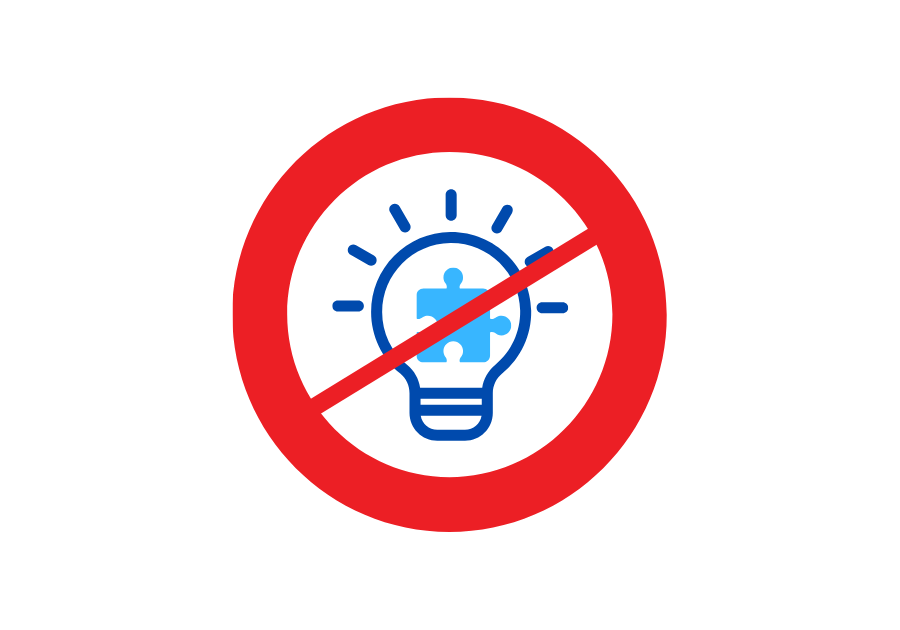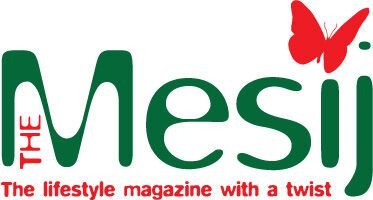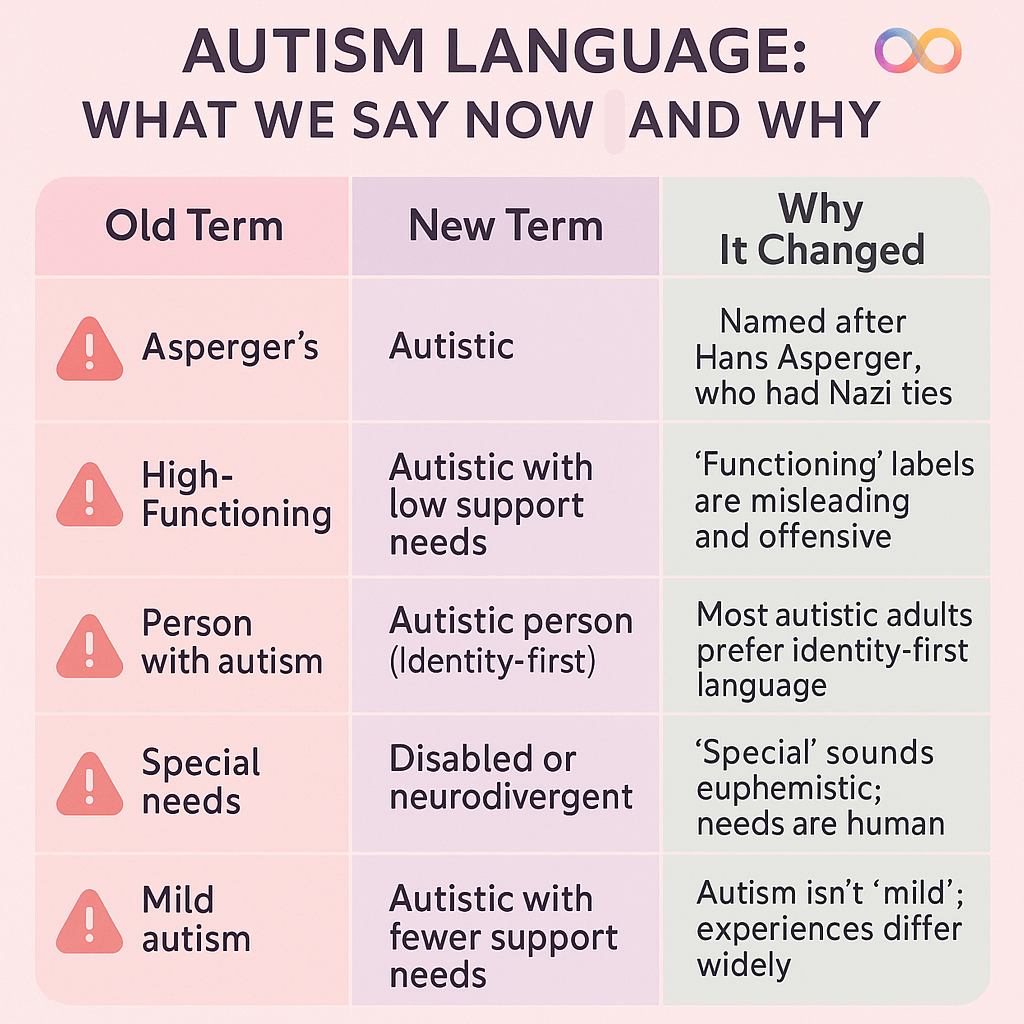Let’s face it. The language around autism and neurodivergence is moving faster than a toddler after sugar. One minute you’re nodding along to someone describing their “high-functioning Asperger’s,” and the next, you’ve learned that term went out of fashion quicker than skinny jeans at a Gen Z picnic.
But here’s the good news: all these changes? They’re not just fads or internet fluff. They’re part of a much-needed shift towards respect, accuracy and actual inclusion. Still, keeping up with it all can feel a bit like trying to follow the plot of a Christopher Nolan film – backwards, in Klingon, while juggling.
So I’ve done a little digging. A little lurking. And I’ve put together this guide to help you (and the people you love) stay in the loop, support others properly, and not accidentally offend the entire internet.
Because let’s be real: nobody wants to be that well-meaning aunt who still thinks lighting it up blue means you’re doing something good.
Outdated Autism Terms (And Why They’ve Got the Boot)
If you’ve been around a while, you might still be using terms that once sounded helpful, but now make many autistic folk wince. Let’s break a few down.
Asperger’s Syndrome
Ah yes. The term that once felt like a more ‘palatable’ version of autism. What most people don’t know is Hans Asperger, the Austrian paediatrician it was named after, had links to the Nazi regime. His work involved classifying children as either “valuable” or not. I mean… grim.
Today, most people prefer to just say autistic. Simple. Honest. No Nazi baggage, thanks.
High-Functioning and Low-Functioning
These sound helpful, but in reality they reduce people to how useful they appear to neurotypicals. Someone who’s verbal and employed might be labelled “high-functioning”, but that doesn’t mean they’re not struggling internally. And someone non-verbal might be “low-functioning” despite having an inner world brighter than a firework factory.
Instead, we talk about support needs or access needs. Because how someone presents isn’t the full picture.
Mild or Severe Autism
Autism isn’t a seasoning. It’s not “mild” like salsa or “extra spicy” like a bad curry night. Again, this language centres how you perceive their traits, not how they experience the world.
Better terms? Try profound autism (used respectfully), or autistic with higher support needs.
Special Needs
We’ve been phasing this one out too. The needs aren’t “special” – they’re human. Many now prefer disabled, neurodivergent, or has access needs – all of which centre reality over euphemism.
The Puzzle Piece: From Beloved to Bewildering

Right, let’s talk icons. The puzzle piece was first used in the 1960s by the National Autistic Society in the UK. They meant well, bless them. But here’s the problem: it depicted autism as a tragic, mysterious riddle. A thing to be solved. And let’s not ignore the giant crying child on the original logo…
Over time, many autistic adults began pushing back. “I’m not a puzzle,” they said. “I’m not missing a piece.”
Enter the infinity loop. Often gold or rainbow-coloured, it symbolises the diversity and infinite variation of neurodivergent minds. Unlike the puzzle piece, it doesn’t suggest you’re broken, or that only children can be autistic (as we all know you can’t grow out of it).
Autism Speaks: The Controversy that Won’t Go Quietly
If you’ve ever supported “Autism Speaks” or lit your porch up blue in April, don’t panic. Most people did so with the best intentions. But here’s why many autistic adults are now yelling “No thank you” at both.

Autism Speaks has long been criticised for:
- Centring non-autistic voices
- Promoting “curing” autism
- Pouring funds into genetics research instead of support
- Glorifying ABA therapy (which many describe as trauma in disguise)
- Using fear-based campaigns, portraying autistic people as burdens
And the whole “light it up blue” thing? That started as their initiative. But now, autistic-led groups prefer red, gold, or even multicolour to represent the spectrum properly. Blue, many argue, reinforces the (outdated) idea that autism is mostly a boy thing.
What Was ABA Therapy, and Why Is It So Controversial?
Applied Behaviour Analysis (ABA) was once the gold standard for “treating” autism, especially in children. But its core approach was about making autistic people appear more neurotypical through rigid behaviour drills, forced eye contact, and suppression of stimming. Many who went through it describe it as emotionally harmful and compliance-focused, leaving lasting trauma and masking habits. Imagine being trained out of your instincts, just to be more “palatable”. Not quite the therapeutic hug it was sold as.
Say This Instead: A Pocket Guide for Non-Cringe Conversation
Even the well-meaning can trip up. So here’s a mini crash course in getting it right (or at least not wildly wrong).
- “Autistic person” vs “Person with autism”: Most autistic adults prefer identity-first language. It’s not a disease – they are autistic. That said, always respect individual preference.
- Aspie / Aspergian: While some self-diagnosed folk still use these, they’re increasingly avoided because of their links to Hans Asperger and the implied hierarchy.
- Neurodivergent vs Neurotypical: ND is the umbrella term for those with brains that diverge from the norm (ADHD, autism, dyslexia, etc). NT means you’re not. Simples.
- AuDHD: Short for people who are both autistic and ADHD. It’s a thing. A powerful, distractible, beautifully chaotic thing.
- Spiky Profile: This refers to wildly inconsistent skill levels – say, being able to code a website in an hour but forgetting how to boil pasta.
- Neurokin: Online shorthand for people who share similar neurodivergent traits and connect over them, often in supportive communities.
These Changes Are Coming from the Right People
Let’s be clear: most of these shifts aren’t coming from academics, corporations or therapists. They’re being pushed by autistic adults themselves. The late-diagnosed. The chronically misunderstood. The tired-of-being-told-they’re-too-much crew.
Movements like #ActuallyAutistic have helped reframe the conversation, shifting power from people speaking about autism to those speaking as autistic. And that’s how it should be.
You don’t see a non-pregnant bloke running Mothercare, do you?
Final Thoughts: It’s Not “Too PC” It’s Just Polite
Language evolves. We’ve stopped calling left-handed people “sinister” and unmarried women “spinsters” (well, most of us). So why should autism still be described using 1950s leftovers?
Learning new terms doesn’t mean walking on eggshells. It means building bridges. It’s saying, “I care enough about you to say what you prefer.”
So next time someone bristles when you say “high-functioning,” or gently corrects your use of “Asperger’s,” don’t take offence. Take notes.
Because the more we update our language, the more we update our hearts.
Over to you:
Which autism-related phrases have you seen used awkwardly, or proudly reclaimed? Do you think we’re evolving fast enough?




